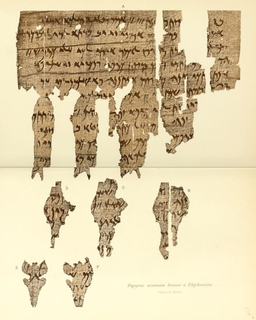
Papyrus is a material similar to thick paper that was used in ancient times as a writing surface. It was made from the pith of the papyrus plant, Cyperus papyrus, a wetland sedge. Papyrus can also refer to a document written on sheets of such material, joined together side by side and rolled up into a scroll, an early form of a book.

Khnum or also romanised Khnemu was one of the earliest-known Egyptian deities, originally the god of the source of the Nile. Since the annual flooding of the Nile brought with it silt and clay, and its water brought life to its surroundings, he was thought to be the creator of the bodies of human children, which he made at a potter's wheel, from clay, and placed in their mothers' wombs. He was later described as having moulded the other deities, and he had the titles "Divine Potter" and "Lord of created things from himself".

Satet,Satit or Satjet, Satjit in Ancient Egyptian, Greek: Satis, also known by numerous related names, was an Upper Egyptian goddess who, along with Khnum and Anuket, formed part of the Elephantine Triad. A protective deity of Egypt's southern border with Nubia, she came to personify the former annual flooding of the Nile and to serve as a war, hunting, and fertility goddess.

Elephantine is an island on the Nile, forming part of the city of Aswan in Upper Egypt. There are archaeological sites on the island.
Bethel meaning in Hebrew and Phoenician and Aramaic 'House of El' or 'House of God' is seemingly the name of the God or an aspect of the God in some ancient middle-eastern texts dating to the Assyrian, Persian and Hellenistic periods. According to the Bible, Jacob (Israel) called the name of the place where God had spoken with him "Bethel".
Ashima is an ancient Semitic goddess.

Amyrtaeus or Amyrtaios of Sais, is the only pharaoh of the Twenty-eighth Dynasty of Egypt and is thought to be related to the royal family of the Twenty-sixth Dynasty. He ended the first Persian occupation of Egypt and reigned from 404 BC to 399 BC. Amyrtaeus' successful insurrection inaugurated Egypt's last significant phase of independence under native sovereigns, which lasted for about 60 years until the Battle of Pelusium in 343 BC.

The Tetragrammaton or Tetragram is the four-letter Hebrew word יהוה, the name of the biblical god of Israel. The four letters, read from right to left, are yodh, he, waw, and he. While there is no consensus about the structure and etymology of the name, the form Yahweh is now accepted almost universally.

Egyptian medical papyri are ancient Egyptian texts written on papyrus which permit a glimpse at medical procedures and practices in ancient Egypt. The papyri give details on disease, diagnosis, and remedies of disease, which include herbal remedies, surgery, and magical spells. It is thought there were more medical papyri, but many have been lost due to grave robbing. The largest study of the medical papyri to date has been undertaken by Humboldt University of Berlin and was titled Medizin der alten Ägypter.

The Brooklyn Papyrus is a medical papyrus dating from ancient Egypt and is one of the oldest preserved writings about medicine and ophiology. The manuscript is dated to around 450 BC and is today kept at the Brooklyn Museum in New York.

Charles Edwin Wilbour was an American journalist and Egyptologist. He was one of the discoverers of the Elephantine Papyri. He produced the first English translation of Les Misérables.
Johanan, son of Joiada, was the fifth high priest after the rebuilding of the temple in Jerusalem by the Jews who had returned from the Babylonian captivity. His reign is estimated to have been from c. 410–371 BCE; he was succeeded by his son Jaddua. The Bible gives no details about his life. Johanan lived during the reigns of king Darius II of Persia and his son Artaxerxes II, whose Achaemenid Empire included Judah as a province.

Yehud, or Yehud Medinata, alternatively Yehud Medinta, was the name retained and used by the Persian Achaemenid Empire for one of their administrative provinces, after it first being introduced by the Babylonians. The territory of the Persian colony, which was ruled by mostly Jewish governors, was considerably smaller and with a far thinner population than the kingdom of Judah before the Babylonian conquest. The area of Persian Yehud corresponded to the previous Babylonian province of Yehud, which was formed after the fall of the kingdom of Judah to the Neo-Babylonian Empire. Yehud, part of the Persian satrapy of Eber-Nari, continued to exist for two centuries, until being incorporated into the Hellenistic empires following the conquests of Alexander the Great.

Arsames was an Achaemenid satrap of ancient Egypt during the 5th century BC, at the time of the 27th Dynasty of Egypt.

The Story of Aḥiqar, also known as the Words of Aḥiqar, is a story first attested in Imperial Aramaic from the fifth century BCE on papyri from Elephantine, (Egypt) that circulated widely in the Middle and Near East. It has been characterised as "one of the earliest 'international books' of world literature".
Otto Rubensohn was a German-Jewish classical archaeologist.
The Wilbour Papyrus is a papyrus purchased by the New York journalist Charles Edwin Wilbour from a farmer when he visited the island of Elephantine near Aswan in 1893. There he purchased seventeen papyri from a local farmer. He did not realize the importance of his find and when he died in a hotel in Paris his belongings, including the papyri, were put in storage by the hotel and not returned to his family for nearly half a century. At the request of his widow, they were donated to the Brooklyn Museum.

Martin Bommas is a German Egyptologist, archaeologist, and philologist. He is Professor and Museum Director at the Macquarie University History Museum in Sydney, Australia and the Director of the Qubbet el-Hawa Research Project (QHRP) in Aswan, Egypt. He has published widely on ancient Egyptian mortuary liturgies, rituals and religious texts spanning the Old Kingdom to the Christian era. In archaeology, he has examined the Old and Middle Kingdom settlement remains and the 18th Dynasty temple of Khnum at Elephantine as well as the Old and Middle Kingdom Lower Necropolis at Qubbet el-Hawa. As a museum director, his focus is on historical anthropology, decolonisation and the repatriation of illicitly trafficked artefacts.
Mibtahiah , was a Jewish businesswoman and banker. She belonged to the first Jewish women of which there is any information outside of the Bible as well as the first of Jewish businesswomen, and she has been the subject of research. She is well documented from the Ancient Arameic papyrus collections from Elephantine in Egypt, known as the Mond-Cecil papyri in the Cairo Museum and the Bodleian papyri, which is also named the Mibtahiah archive after her.























